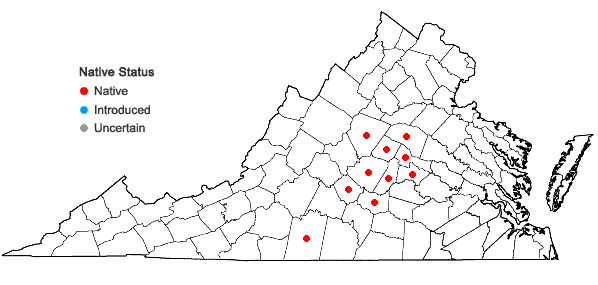Viola communis Pollard

Detail
- Family
- Violaceae
- Botanical Name
- Viola communis Pollard
- Common Name
- Hooded Blue Violet, Confederate Violet
- Synonym(s)
- Viola communis Pollard f. priceana; Viola priceana Pollard; Viola sororia Willd., pro parte
- Flora of Virginia Name/Status
- Included in Viola sororia Willd.
- Comments
- Plants of this species were, until very recently, subsumed within a broader concept of Viola sororia, but Ballard et al. (2020, 2023) resurrected Pollard's original species concept with ample evidence that it is distinct. Although Viola communis is apparently widespread in eastern North America, the map in Ballard et al. (2023) shows few counties across the range, apparently because few herbarium specimens anywhere have been re-examined and annotated. The current map is thus populated with records only from very recent collections and herbarium studies. It will be more fully populated as more data become available. For more information see:
Ballard, H.E., J.T. Kartesz, and M. Nishino. 2023. A taxonomic treatment of the Violets (Violaceae) of the northeastern United States and adjacent Canada. Jour. Torrey Bot. Soc. 150(1): 3-266.
Ballard, H.E. Jr., R. N. Burwell, and S. L. Lockhart. 2020. Violaceae: typifications and clarifications of names. Pp. 217-230 in A.S. Weakley et al. Studies in the vascular flora of the southeastern United States. J. Bot. Res. Inst. Texas 14(2). - Habitat
- The status of this species is somewhat uncertain, since specimens of it were identified as "Viola sororia" for decades. Preliminary field and herbarium studies indicate that it is widespread and common in central Virginia, perhaps even more so than V. sororia. Typical habitats include well-drained alluvial forests, river and stream banks, mesic upland forests, moist clearings, fields, and lawns. The form bearing whitish flowers with central blue lines, named V. priceana by some older references, is known as the "Confederate Violet" and can be locally common in ruderal habitats. Extensive field and herbarium work will be necessary to fully map this species, which is likely to occur more or less state-wide.
- Native Status
- Native
To save this map, right-click (control-click for Mac users) on the map and choose "Save Image As...".



